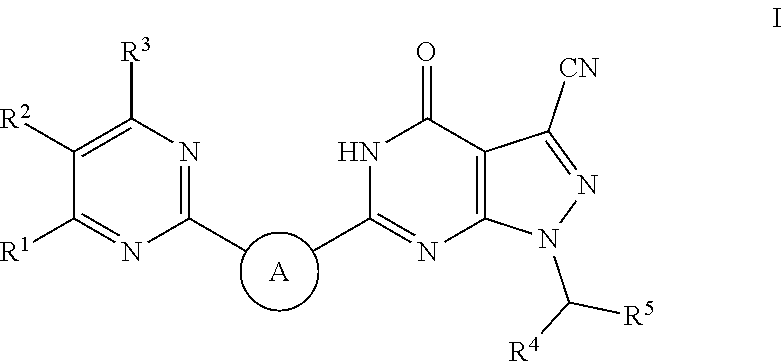Pyrazolopyrimidine pde9 inhibitors
- Summary
- Abstract
- Description
- Claims
- Application Information
AI Technical Summary
Benefits of technology
Problems solved by technology
Method used
Image
Examples
examples 1-4
[0439]
1-(1-(4-Fluorophenyl)ethyl)-4-oxo-6-((1,2-trans)-2-(pyrimidin-2-yl)cyclobutyl)-4,5-dihydro-1H-pyrazolo[3,4-d]pyrimidine-3-carbonitrile
[0440]Step A: (E)-tert-Butyl 2-(1-(4-fluorophenyl)ethylidene)hydrazinecarboxylate. A round bottom flask (2 L) was charged with 1-(4-fluorophenyl)ethanone (50 g, 362 mmol) in Ethanol (1 L), followed by the addition of tert-butyl hydrazinecarboxylate (52.6 g, 398 mmol) and acetic acid (7.61 g, 127 mmol) and the contents were stirred at 90° C. for 4 h. After which, the reaction mixture was cooled to room temperature and concentrated under reduced pressure to get the crude which was washed with petroleum ether (2×50 mL) to afford the title compound which was used without further purification. 1H NMR (400 MHz, DMSO-d6) δ 9.84 (s, 1H), 7.79-7.75 (m, 2H), 7.24-7.19 (m, 2H), 2.19 (s, 3H), 1.48 (s, 9H). LCMS (ES, m / z): 197 [M+H]+.
[0441]Step B: tert-Butyl 2-(1-(4-fluorophenyl)ethyl)hydrazinecarboxylate. To a solution of (E)-tert-butyl 2-(1-(4-fluorophenyl...
examples 5-8
[0451]
4-Oxo-6-((1,2-trans)-2-(pyrimidin-2-yl)cyclobutyl)-1-(1-(6-(trifluoromethyl)pyridin-3-yl)ethyl)-4,5-dihydro-1H-pyrazolo[3,4-d]pyrimidine-3-carbonitrile
[0452]Step A: tert-Butyl 2-(1-(6-(trifluoromethyl)pyridin-3-yl)ethyl)hydrazinecarboxylate. Acetic acid (1.589 ml, 27.8 mmol) was added to a stirred mixture of tert-butyl carbazate (11.53 g, 87 mmol) and 1-(6-(trifluoromethyl)pyridine-3-yl)ethanone (15 g, 79 mmol) in ethanol (375 ml) at ambient temperature and the mixture was stirred at 80° C. for 2 h. The solvent was removed under reduced pressure and acetonitrile (375 ml) and acetic acid (18.16 ml, 317 mmol) were added at ambient temperature followed by sodium cyanoborohydride (9.97 g, 159 mmol). The reaction was heated at 80° C. and after 48 hours at the solvent was removed under vacuum. The crude residue was dissolved in Et2O / H2O (150:50 ml) and pH brought to 13 by carefully adding solid KOH. The organic layer was separated, washed with brine (1×100 mL) dried over Na2SO4 and ...
examples 9-10
[0462]
4-Oxo-6-((1,2-trans)-2-(pyrimidin-2-yl)cyclobutyl)-1-((6-(trifluoromethyl)pyridin-3-yl)methyl)-4,5-dihydro-1H-pyrazolo[3,4-d]pyrimidine-3-carbonitrile
[0463]Step A: (E)-tert-Butyl 2-((6-(trifluoromethyl)pyridin-3-yl)methylene)hydrazine-carboxylate. A round bottom flask was charged with 6-(trifluoromethyl)nicotinaldehyde (10 g, 57.1 mmol) in ethanol (200 mL), followed by the addition of tert-butyl hydrazinecarboxylate (8.30 g, 62.8 mmol) and acetic acid (1.144 ml, 19.99 mmol). The mixture was stirred at ambient temperature for 1 h and the reaction mixture was concentrated under reduced pressure to afford the title compound. 1H NMR (400 MHz, DMSO-d6): δ 11.31 (s, 1H), 8.94 (s, 1H), 8.29-8.26 (m, 1H), 8.12 (s, 1H), 7.94 (d, J=11.20 Hz, 1H), 1.49 (s, 9H). LCMS (ES, m / z): 290 [M+H]+.
[0464]Step B: tert-Butyl 2-((6-(trifluoromethyl)pyridin-3-yl)methyl)hydrazine-carboxylate To a solution of (E)-tert-butyl 2-((6-(trifluoromethyl)pyridin-3-yl)methylene)-hydrazinecarboxylate (15.2 g, 52.5...
PUM
| Property | Measurement | Unit |
|---|---|---|
| concentration | aaaaa | aaaaa |
| catalytic domain homology | aaaaa | aaaaa |
| catalytic activity | aaaaa | aaaaa |
Abstract
Description
Claims
Application Information
 Login to View More
Login to View More - R&D
- Intellectual Property
- Life Sciences
- Materials
- Tech Scout
- Unparalleled Data Quality
- Higher Quality Content
- 60% Fewer Hallucinations
Browse by: Latest US Patents, China's latest patents, Technical Efficacy Thesaurus, Application Domain, Technology Topic, Popular Technical Reports.
© 2025 PatSnap. All rights reserved.Legal|Privacy policy|Modern Slavery Act Transparency Statement|Sitemap|About US| Contact US: help@patsnap.com



